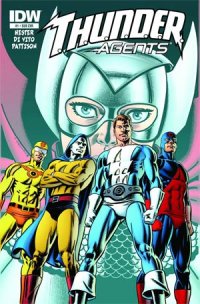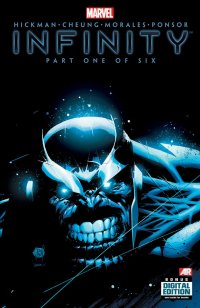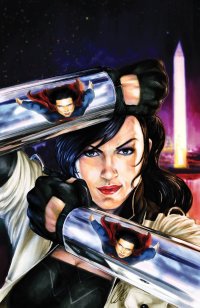T.H.U.N.D.E.R. Agents #1 (IDW, $3.99)
by Graig Kent
It’s been barely a year since DC relaunch of the classic, if perpetually short-lived, Wally Wood creation THUNDER Agents (I’ll dispense with the periods for the sake of my typing sanity) closed ups after an excellent 16-issue run (broken up into two volumes of 10 and 6). DC had held onto the THUNDER Agents license for over a decade, but only ever managed to get the six hardcover reprint volumes into print before finally doing something with the property. Critically the series was well received, and then-writer Nick Spencer did an admirable job in both continuing the storyline of the original series while also being accessible to newcomers and establishing its own sensibilities – but it just wasn’t performing up to DC’s standards (plus Spencer admirably kept the Agents out of the DCU proper).
With the Archives out of the way and their shot at an ongoing a bust, DC let go of the property which was quickly (shockingly so) snapped up by IDW. Without getting into the even longer, convoluted publishing history of THUNDER Agents, DC’s run was the longest since the original 20-issue run in the 1960s. While the THUNDER Agents have never been wildly successful, the concepts and characters have endured, and with the thresholds of the smaller press of today being that much lower than the Big Two, there’s a definite shot of an ongoing having a lengthy run at IDW.
Of course for a successful relaunch of a marginal, decades-old property, IDW would have to assemble a creative team and present a product that would both please the old fans and have the potential to gain new ones. With the announcement that Phil Hester and Andrea Di Vito were handling writing and art chores respectively, any doubt from the fans should have washed away. Hester is one of comics’ best kept secrets, an incredible writer whose work has been confined to primarily IDW and Dynamite titles, but is always well-above-average output, with thoughtful plotting, snappy dialogue and always a way of making the familiar seem fresh. Di Vito meanwhile blew me away with his stunning classic big comic book style on the original Annihilation and Nova thereafter. He’s been toiling around Marvel ever since, but hasn’t had another big spotlight project that he deserves until now.
If there was a superhero project that could highlight both these men’s talents, this would be it, and the results are even better than anticipated. Unlike DC’s take (and the duelling JC and Deluxe Comics mini-runs in the early 1980’s) Hester approaches the THUNDER Agents anew rather than as a continuation of the original arc. But having their cake and eating it too, the story begins with the THUNDER Agents already established, and their recent mission to take down criminal mastermind Iron Maiden a failure. Lightning is captured, potentially dead, Noman’s surrogate body was destroyed, his invisibility cloak in the enemy’s hands, and worst off, there seems little The Higher United Nations Defense Enforcement Reserves can do to stop her, she’s too well prepared. Their only hope is to find someone capable of utilizing the Thunderbelt, a tricky piece of technology that enhances the user’s strength a thousand fold, but has a severe physical toll. Enter ex-hockey goon and small-time strongarm Leonard Brown, a hardworking man just looking for an opportunity to present itself.
I don’t remember the last time a comic made me feel like a kid again while reading it, but this definitely took me back. Hester presents a straightforward, clean, classic comic book story of bad guys and good guys, with a briskly told origin story to boot. He gets in all the salient details effortlessly without feeling overwhelmed with exposition, and leaves a lot unsaid but also not requiring further elaboration so immediately. Di Vito for his part draws big and bold, thick lines define the characters distinctly from the spare backgrounds, presenting only the necessary details to capture the scene. This is just vintage comic book illustrating, dynamic figure work, but not showy in his layouts servicing the story, rather than any artsy compulsion. His figures are classically styled and muscled, idyllic and ready-made for action figures (yes please!). Though obviously well-advanced from the four-color separation of old, colorist Rom Fajardo delivers a vibrant color scheme that doesn’t try at all for naturalism. This very much feels like a superhero comic meant for everyone, especially that oft-neglected pre-teen agegroup, without being juvenile about it.
While the DC comics version was more sophisticated in a sense, and genuinely good reading, it wasn’t nearly as much fun as this is. A long, healthy run is looking good.
Rating: 




Out of a Possible 5 Stars
 Infinity # 1 of 6 (Marvel, $3.99)
Infinity # 1 of 6 (Marvel, $3.99)
By Jeb D.
I don’t know if it was inevitable that the scrappy energy of the National/DC comics of the 1930’s and 40’s, or the Marvel comics of the 1960’s and 70’s, would finally give way to the corporate intellectual property incubators that they are today, but any consideration of current output from the Big 2 has to be viewed in that light: given that any comic exists more to support a multi-media brand than to do anything as recondite as tell an entertaining story to its audience, it’s tempting to evaluate these Big Comic Events not in light of how good they are, but rather how bad they aren’t. There’s plenty of unreadable tripe coming out of the two big spandex factories these days, even when good creators are involved (I never even finished the first issue of Jason Aaron’s Thanos Rising, despite him being one of my favorite current writers: the idea of the Death-obsessed Titan spending his middle school years as a lonely misfit was more than I could handle); so when Jonathan Hickman and Jim Cheung can shape something worthwhile out of the standard Big Event playbook, you stand grateful for small favors, even if you’d really rather be reading the next issue of The Manhattan Projects.
The biggest improvement that Infinity shows over Marvel’s most recent monster rally, Age of Ultron, is the way that Hickman has laid the groundwork for it over his Marvel Now! outings, most notably with Secret Avengers (side note: Black Swan is my favorite new Marvel character since the Winter Soldier, and I hope she comes out ahead in this thing); ironic, of course, since AOA‘s Brian Bendis has been running the House of Ideas for over a decade, and could have found a hundred ways to make AOA feel organic, rather than something that popped up out of nowhere for no better reason than to give Joss Whedon the title for his next movie. Here, characters like Ex Nihilo and the new Captain Universe had effective story arcs on their own, but each brings something distinctive to their participation in the buildup to Infinity. That’s equally true of Hickman’s use of longtime Marvel U stalwarts like the Shi’ar, as well as the long-lost (and inexplicably beloved) Spaceknights. In most genre fiction, there’s a certain amount of obligatory scene-setting that has to be addressed before things get properly ramped up: if you’re reading a murder mystery, you take it for granted that you have to wait for someone to get killed before things can get underway; similarly, when you read a big superhero crossover event, you’re going to spend some introductory time establishing the threat and rallying the troops. Hickman handles that exposition deftly, and when characters need to fill in the audience on key bits of background, he manages to make sure that at least some of the cast members are learning new things about the central space-born threat at the same time, so there’s no sense of wheels spinning.
The specifics of that threat are perhaps the book’s weakest point: another round of bunches and bunches of heroes versus one more set of unstoppable interstellar killing machines, though Hickman characterizes his villains well: the scene where one of them confronts an alien king with the broken, bloodied sword of the son he had sent into battle is coldly moving, and the disquieting subtext about the nature and cost of heroism that Hickman has been playing with since he took on the Avengers franchise is underlined when Captain America leads his team against what he perceives as a group of deadly foes, with uncomfortable results. Hickman also leaves us with a bit of a twist at the end, suggesting that he (and Thanos) have something different up their sleeves than the reader might have expected coming in.
Jim Cheung’s art (with inks from Mark Morales, John Livesay, and David Meikis, going back to the Free Comic Book Day issue that made up the first twenty pages of this issue) is up to his usual high standard, particularly since almost all the action involves aliens and robots, rather than the Marvel heroes, and he finds way to add the visual flair that we’d noramlly get from the flowing capes and/or hair of Thor or Spider-Woman, Hawkeye’s arrows or Cap’s shield; in particular, he has a great feel for the battle prowess of the Inhumans, whose significant presence here would be more welcome if it didn’t feel like mostly a setup for Matt Fraction’s upcoming Inhumans Event.
In the first issue of Infinity, Hickman has laid the foundation for a pretty good spacebuckling adventure, and I won’t be at all surprised if he can bring Thanos some of the eccentrically glorious villainy that Jim Starlin gave him (and few have approached since). I’m sorry that Cheung evidently won’t be around for future issues, but Jerome Opena and Dustin Weaver are certainly capable enough. And if we must have the obligatory listing of all the upcoming crossover issues to purchase, it’s nice to have it in the form of one of Hickman’s stylish infographics. I just wish I could muster a little more enthusiasm for the launch of a well-conceived, well-executed superhero epic. I must be getting old.
Rating: 




Out of a Possible 5 Stars
Smallville Season 11 #16 (DC Comics, $3.99)
by Graig Kent
It seems that for the past three years or so, a week hasn’t gone by without someone in the comics bloggerati lamenting the lack of a Wonder Woman movie. Just do a something-search for “Wonder Woman Movie” and see all the many, many, many articles written on the subject, questioning/rationalizing why it hasn’t happened yet. The latest comes from MMA fighter and sure to be VOD-superstar Gina Carano, not saying she’s the right person for the role (she’s got the physique and the beauty, but not the acting chops alas), but just that the movie should happen, and it should be done right, and without delay. Extending beyond that, the conversation of female superheroes in summer blockbusters has been an exceptionally hot topic as Marvel’s been releasing their slate of movie titles for the next 4 years, with more on the horizon planned through 2021. It’s kind of ridiculous that the only prominent female superhero of the past 5 years has been Black Widow, with Halle Berry’s Storm and Famke Jansson’s Jean Grey, and Hit-Girl, I guess, quite far behind. While Underworld and Resident Evil prove that there’s an audience for kick-ass female franchises, they just don’t seem to be drawing big enough numbers for the major studios to feel confident putting hundreds of millions behind. But get a good writer and director and it’ll happen, with a surprising ease and as soon as one makes bank, finally the floodgates will open.
But if you want to see a kick-ass rendition of Wonder Woman, Brian Azzarello and Cliff Chiang are doing it monthly at DC. But if you want to see a kick-ass version of Wonder Woman that could work on the either the big or small screen, just take a look at this issue of Smallville. Brian Q. Miller introduces Diana with such ease, with such equal parts power, class and, yes wonder, he makes it look ridiculously simple. He toys with the Steve Trevor thing quite nicely, making him the first man to set foot on Paradise Island… as a boy. Duh, establish a childhood bond between Diana and Steve, instead of making it an adult thing. So simple. I mean, in general I don’t think Diana needs Steve Trevor, but when you can do it this well, why not?
If this were an actual Season 11 Smallville TV show, this would be the Wonder Woman backdoor pilot. There’s no way everyone watching wouldn’t want a Wonder Woman TV show by the time the first commercial break hits. And the costume design, in fitting with the natural, real-world style of Smallville, finds Diana in garb more akin to her early 70’s white pantsuit, but looking really, really good.
Miller loops the DEO (Department of Extranormal Operations) into the Smallville world with this issue as well, including Director Bones (he’s skeletal, but not a skeleton), tying it in with the mishandled Checkmate aspects from Season 9 and 10, which also saw Ma Kent as its white queen. Can I say that Smallville Ma Kent is the most useful Ma Kent ever? She’s not just Clark’s moral support, but an example of the can-do attitude she taught him… a State Senator and a secret military operative… so great to get her outside of her narrow box. As well, Steve Trevor is part of the DEO, and while Clark goes for a visit, Lois goes hunting for the new mystery woman. As world collide, Steve, another Military Brat, we learn also happens to be one of Lois’ ex-boyfriends… because of course he is! I think the title “Smallville” is now more in reference to how closely woven this DC TV Universe is than the homestead where Clark grew up. There’s also mention of Connor – who we don’t get to meet again, but I’m sure it’s just a matter of time – and the white martian incident from the first Smallville S11 Special a month or two ago.
This is just insanely entertaining all around. If Azzarello ever leaves Wonder Woman, Miller’s the guy to pick up the torch (or give her a second series even), or if another TV series is in the works, he’s the guy to run it.
Rating: 




Out of a Possible 5 Stars